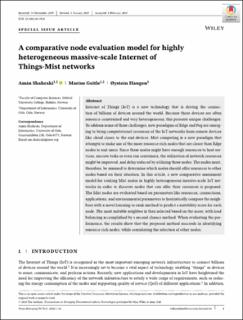| dc.contributor.author | Shahraki, Amin | |
| dc.contributor.author | Geitle, Marius | |
| dc.contributor.author | Haugen, Øystein | |
| dc.date.accessioned | 2020-10-23T08:24:04Z | |
| dc.date.available | 2020-10-23T08:24:04Z | |
| dc.date.created | 2020-05-05T18:36:04Z | |
| dc.date.issued | 2020-03-09 | |
| dc.identifier.citation | Transactions on Emerging Telecommunications Technologies. 2020, 1-28. | en_US |
| dc.identifier.issn | 1124-318X | |
| dc.identifier.uri | https://hdl.handle.net/11250/2684689 | |
| dc.description.abstract | Internet of Things (IoT) is a new technology that is driving the connection of billions of devices around the world. Because these devices are often resource‐constrained and very heterogeneous, this presents unique challenges. To address some of these challenges, new paradigms of Edge and Fog are emerging to bring computational resources of the IoT networks from remote devices like cloud closer to the end‐devices. Mist computing is a new paradigm that attempts to make use of the more resource‐rich nodes that are closer than Edge nodes to end‐users. Since these nodes might have enough resources to host services, execute tasks or even run containers, the utilization of network resources might be improved, and delay reduced by utilizing these nodes. The nodes must, therefore, be assessed to determine which nodes should offer resources to other nodes based on their situation. In this article, a new comparative assessment model for ranking Mist nodes in highly heterogeneous massive‐scale IoT networks in order to discover nodes that can offer their resources is proposed. The Mist nodes are evaluated based on parameters like resources, connections, applications, and environmental parameters to heuristically compare the neighbors with a novel learning‐to‐rank method to predict a suitability score for each node. The most suitable neighbor is then selected based on the score, with load balancing accomplished by a second chance method. When evaluating the performance, the results show that the proposed method succeeds in identifying resource‐rich nodes, while considering the selection of other nodes. | en_US |
| dc.language.iso | eng | en_US |
| dc.publisher | Wiley | en_US |
| dc.rights | Navngivelse 4.0 Internasjonal | * |
| dc.rights.uri | http://creativecommons.org/licenses/by/4.0/deed.no | * |
| dc.title | A comparative node evaluation model for highly heterogeneous massive‐scale Internet of Things‐Mist networks | en_US |
| dc.type | Peer reviewed | en_US |
| dc.type | Journal article | en_US |
| dc.description.version | publishedVersion | en_US |
| dc.subject.nsi | VDP::Teknologi: 500::Informasjons- og kommunikasjonsteknologi: 550::Datateknologi: 551 | en_US |
| dc.source.pagenumber | 1-28 | en_US |
| dc.source.journal | Transactions on Emerging Telecommunications Technologies | en_US |
| dc.identifier.doi | 10.1002/ett.3924 | |
| dc.identifier.cristin | 1809531 | |
| cristin.ispublished | true | |
| cristin.fulltext | original | |
| cristin.qualitycode | 1 | |

